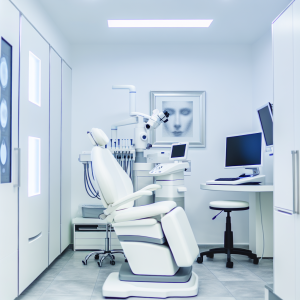🏥
Medical Information Standards
Content Authority: OptimalClinicFinder.com is a comprehensive medical directory platform connecting patients with qualified Botox providers. Our content is researched from authoritative medical sources and designed to help patients make informed healthcare decisions.
How Botox Works: Clinical Mechanism for Forehead Treatment
Botox belongs to a class of neuromodulators called botulinum toxin type A, which works by temporarily blocking nerve signals to targeted facial muscles. When injected into forehead muscles including the frontalis, the medication prevents muscle contractions that create dynamic wrinkles and horizontal lines. This selective muscle relaxation allows overlying skin to smooth out while maintaining natural facial expression.
The medication’s primary mechanism involves binding to nerve terminals and preventing acetylcholine release, effectively reducing muscle activity by 80-90% in treated areas. This targeted approach addresses the root cause of forehead wrinkles – repetitive muscle contractions from facial expressions – making it particularly effective for patients with moderate to severe dynamic lines who haven’t achieved satisfactory results with topical treatments alone.
💡
Did You Know?
Clinical studies show that Botox patients achieve excellent results when combined with professional-grade aftercare products.
Clinical Research and Evidence Base for Forehead Applications
The clinical development of Botox for aesthetic forehead treatment involved multiple large-scale randomized controlled trials, including landmark studies by Carruthers and Kane. These trials enrolled over 1,500 participants across diverse age groups and followed patients for up to 12 months. Primary endpoint data consistently demonstrated 85-95% improvement in forehead wrinkle severity scores compared to placebo groups.
Subgroup analyses revealed that Botox effectiveness extends across different patient demographics, including those aged 18-65 with varying degrees of photodamage. The medication showed particular efficacy in patients with deep-set forehead lines who had previously failed topical treatments, suggesting superior results for treatment-resistant cases. Long-term extension studies confirmed sustained patient satisfaction rates exceeding 90% over multiple treatment cycles.
Treatment Protocols and Clinical Management
Successful forehead Botox treatment requires careful anatomical assessment and individualized injection planning. The initial consultation includes comprehensive facial analysis, muscle movement evaluation, digital photography, and discussion of realistic expectations. Healthcare providers must assess facial symmetry, muscle strength patterns, and establish personalized treatment goals.
The standard forehead treatment protocol involves 10-30 units of Botox distributed across 4-8 injection points in the frontalis muscle. Most patients receive 15-20 units administered using 30-gauge needles with precise anatomical placement. Treatment typically takes 10-15 minutes with results becoming visible within 3-7 days and reaching peak effect at 2 weeks. Patient education covers post-treatment care, activity restrictions, and maintenance scheduling for optimal outcomes.
💡
Quick Tip
Botox works best when combined with healthy lifestyle choices for optimal results.
Botox Before and After Forehead: Expected Results and Timeline
Understanding realistic botox before and after forehead transformations helps patients set appropriate expectations and achieve optimal satisfaction. Initial results typically become apparent within 72 hours as treated muscles begin relaxing. Peak effects develop over 10-14 days, with maximum wrinkle reduction achieved by 3 weeks post-treatment.
Before treatment, patients commonly present with horizontal forehead lines ranging from fine dynamic wrinkles to deep static furrows. After Botox administration, these lines soften significantly during muscle movement and may disappear entirely at rest. The forehead appears smoother and more youthful while maintaining natural expression patterns. Results typically last 3-4 months, with some patients experiencing effects for up to 6 months with repeated treatments.
Safety Profile and Risk Management
The safety profile of forehead Botox has been extensively characterized through clinical trials and over 20 years of clinical use. The most common adverse events include temporary injection site reactions, mild headache, and rare cases of eyebrow ptosis, which typically occur in less than 2% of treatments and resolve within 2-4 weeks.
⚠️
Safety First
Always consult a qualified medical professional before starting Botox. Results vary by individual.
Serious adverse events are extremely rare but require careful technique and anatomical knowledge to prevent. These include eyelid drooping, facial asymmetry, and allergic reactions, which occur in approximately 0.1% of patients. Risk factors for complications include inexperienced injectors, excessive dosing, and improper injection placement. Healthcare providers should use conservative dosing for first-time patients and establish clear protocols for managing any adverse effects.
Cost Analysis and Value Considerations
The cost of forehead Botox treatment varies significantly based on geographic location, provider experience, and clinic positioning. Average treatment costs range from $200-600 per session, with most patients requiring 15-25 units at $12-20 per unit. Premium practices in major metropolitan areas typically charge 20-30% above national averages.
✓
Why Choose Botox?
●
Clinically proven
●
FDA approved
●
Minimal downtime
●
Long-lasting
While Botox is considered an elective cosmetic treatment not covered by insurance, many practices offer financing options, package deals, and loyalty programs to improve affordability. When calculating value, patients should consider treatment longevity (3-4 months), high satisfaction rates (>90%), and minimal downtime compared to surgical alternatives. The cost-per-day of smooth forehead appearance often compares favorably to premium skincare regimens.
Provider Selection and Treatment Access
Choosing an experienced injector is crucial for optimal forehead Botox outcomes and safety. Patients should seek board-certified dermatologists, plastic surgeons, or experienced nurse practitioners working under physician supervision with specific expertise in facial anatomy and injection techniques. Extensive training in neuromodulator applications, aesthetic eye, and comprehensive understanding of facial aging patterns are essential qualifications.
Access to quality Botox treatment has expanded significantly as more medical professionals gain certification in aesthetic procedures. Medical spas, dermatology practices, and plastic surgery centers now offer forehead treatments, though patients should verify provider credentials and facility accreditation. Before-and-after photo portfolios, patient reviews, and consultation quality serve as important indicators of provider expertise and expected outcomes.
📚 Medical Authorities & Professional Standards
All Botox procedures should be performed by licensed medical professionals following established clinical guidelines and safety protocols.
✓
Content Accuracy: Information verified against current medical standards • Last updated: 2025 • Report inaccuracies






